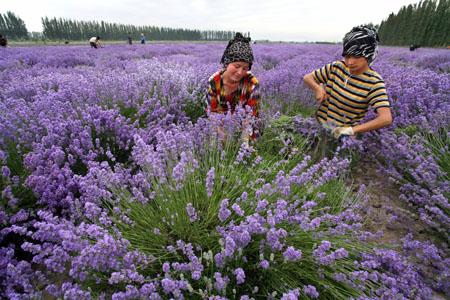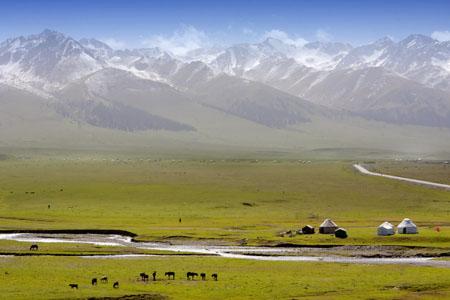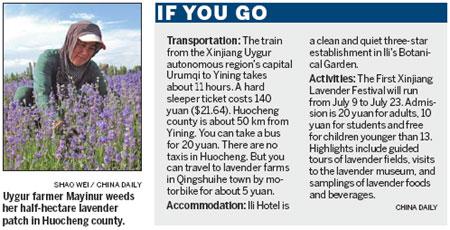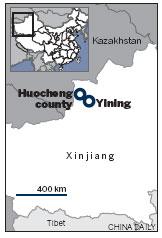
Farmers collect lavender from vast stretches of fields which look like an ocean of brilliant purple in Ili Kazak autonomous prefecture, Xinjiang. [Photo / Agencies]

Ili Kazak autonomous prefecture has long been known for its prairie sceneries. [Photo / Agencies]

Lavender production creates stunning sceneries and economic opportunities in rural Xinjiang. Shao Wei reports.

Some say you can never realize how large China is until you visit the Xinjiang Uygur autonomous region - an area the size of Iran that takes up about a sixth of the country's land mass. I say you can never know how beautiful Xinjiang is until you visit the Ili Kazak autonomous prefecture's prairies.
The greatest delights I found in Ili this June were discovered while exploring the small suburban town of Qingshuihe - literally, "Clearwater River" - in Ili's Huocheng county.
As I sat on the bus from the prefecture's capital, Yining city, purple fields shimmered among strips of wheat and corn, creating a patchwork of colors like a colossal agrarian quilt.
It was in one of these fields that I met Mayinur, a Uygur farmer who was weeding her half-hectare lavender patch.
The 37-year-old mother of two was happy to let me snap a photo of her and her field.
"You're lucky to have come here just in time. Mid-June is the most beautiful season, as the flowers are in full bloom," she tells me, with a shy smile.
We had some difficulties communicating - both my Uygur and her Mandarin are poor. She clipped a bundle, handed it to me and said, "Smell it. Isn't it beautiful?"
The sun flung bright rays on the small, purple flowers in my hand, gilding the blooms with a layer of golden light.
Mayinur told me the long, sunny days and showers that fall at dusk nearly every sunset have made the lavender vibrant.
"We've had many compliments from visitors, who say our lavender looks amazing this year," she says.
My throat was dry after our 40-minute chat, and Mayinur invited me to have some tea at the field's edge, where a row of towering poplars offered a refreshing shade.
"This is the lavender tea I made in my own style. Just put a smidgen of lavender oil in black tea," she says, handing me a cup.
"Just a small drop of lavender oil is enough for a big teapot. It's very good for your stomach."
I sipped it. The floral aroma flooded my nostrils and mouth, and buoyed my spirits, which were starting to wilt in the heat of the day.
Mayinur says the oil should be extracted within two hours after the flowers are harvested.
"We have to work fast," she explains.
Mayinur has grown lavender for three years. Because the plants need to grow for a year or two to yield oil, she expresses high hopes for this year's harvest.
"I think I can earn at least 30,000 yuan ($4,637) from lavender this June," she says.
Lavender has created a gold rush for farmers like Mayinur in Huocheng, a Silk Road stronghold and Qing Dynasty (1644-1911) economic and cultural hub.
Consequently, 52-year-old Yuan Qi, who has made his living growing wheat for 20 years, is considering planting lavender next year.
One mu (0.067 hectares) of lavender can bring in about 5,000 yuan ($773) - about five times what can be earned from a mu of wheat, says Yuan, who also works as a field hand at a lavender farm.
"Lavender is much easier to plant here than wheat and corn," he says. "The climate is ideal for it. And the plant naturally repels insects."
Huocheng is at the same latitude as the world-acclaimed "homeland of lavender", southern France's Provence. This gives the county similar climatic conditions and makes it ideal for cultivating the flora.
Lavender was first planted in Huocheng in the 1960s, and the cultivation area has expanded to more than 1,340 hectares.
The county's lavender-planting base, China's biggest, is one of eight zones worldwide that are famous for lavender.
Its yields of blooms and essential oils account for 95 percent of the country's total.
The enchanting sunsets over the purple fields draw hordes of photographers from around the country.
Lavender, with its spiky silvery-green leaves and fragrant violet blossoms, has for centuries been prized for its medicinal properties, fragrance and culinary uses.
"To me, it's the smell of sunshine," Yining native Miao Dongrui says. Miao had migrated to big cities but got tired of urban life and returned to the county a few years ago.
The lavender products sales manager also displays an affinity for the color purple. When I met her in her company's office, she was wearing a prune-colored plaid shirt and a pink-purple hairpin, and carried a purple handbag.
She tells me lavender has become part of her life. Enjoying a cup of lavender tea is integral to her daily routine. And the curtains and couch cushions in her home are lavender in color.
"I use lavender soap, lavender pillows and lavender mattresses," she says.
"But my biggest problem with lavender is that my friends in other parts of the country love it so much," she jokes.
"Because they have a growing big appetite for lavender products, I can't just keep giving them away as free gifts from Xinjiang every year."




